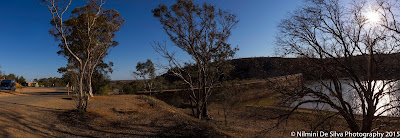We are in Broken Hill - the Silver City. The silver that was
found here became one of the most valuable mineral deposits in the world,
together with lead and zinc deposits that were also discovered. In the early 1900’s the discovery of these
minerals led Broken Hill to be the second largest settlement in NSW after
Sydney. With more than 125 years of
mining history, it has made history as one of the longest continual mining
towns in the world.

Today, the red sunsets, the wide-open spaces, the rusty colours
of the desert have also attracted many artists to the town. Our first stop is at the Living Desert
Sculptures—massive sandstone sculptures carved out of rock by 12 artists from 5
countries. They slept up here for weeks to carve these works and it reminds us
that often we need to escape our normal routines to discover our creativity.
You can’t escape the mining memorial, which looks over the town from on top of
the Line of Lode. Its hard metal exterior reminds us of what work in the mines
was all about and the white roses signify the price these pioneers paid. Over
the more than 100 years of mining history more than 800 miners lost their lives.
One consequence of these harsh conditions was that Broken Hill also pioneered
the rise of the union movement. Eventually, the miners won the right to a
decent wage, the 35-hour week and compensation for those who lost their life at
work.
We were pleasantly surprised to learn that AGL is
constructing two large-scale solar PV power plants in NSW with a total capacity
of 155 MW. The project at Broken Hill
will deliver 53 MW and the project at Nyngan the rest. The total cost of this project is estimated
to be $440 million and when completed will be Australia’s largest. We also learnt that AGL is Australia’s largest
integrated renewable energy company with a mix of hydro, wind, biomass and
solar assets. It makes sense to build solar power stations in places such as
Broken Hill, given its high level of solar radiation. It is great to see
projects such as this being constructed in Australia. While this project will enable Broken Hill to
be more resilient with respect to energy, and it is a win for the environment,
it still does not provide the economic and social benefits that a community
solar scheme can deliver to its residents.
While in Broken Hill we also visited the Royal Flying Doctor
outpost. While the majority of people in Australia live along the coast, there
are many people who still choose to live in remote communities. Their lives would be a lot more risky without
this service—the best of its kind around the world. Looking around the Broken
Hill outpost reinforced for us the work they do in ensuring the best of care is
available to people 24 hours a day. The
Royal Flying Doctor Service also led to the creation of the school of the air,
another invaluable service to the children who grow up in these remote stations
in the vast outback.




